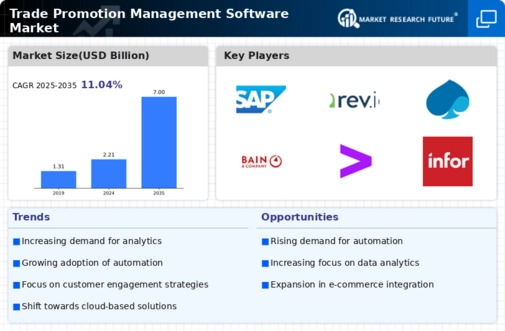Growing Focus on ROI Measurement
The Trade Promotion Management Software Market is increasingly characterized by a growing focus on return on investment (ROI) measurement. Companies are under pressure to demonstrate the effectiveness of their promotional expenditures, leading to a heightened demand for software that can accurately track and analyze promotional performance. This emphasis on ROI is driving organizations to seek solutions that provide comprehensive analytics and reporting capabilities. Recent studies suggest that businesses that implement effective ROI measurement strategies can improve their promotional effectiveness by up to 25%. As a result, the demand for trade promotion management software that facilitates robust ROI analysis is likely to continue to rise, shaping the future of the Trade Promotion Management Software Market.
Rising Competition in Retail Sector
The Trade Promotion Management Software Market is significantly influenced by the rising competition within the retail sector. As retailers strive to differentiate themselves, they are increasingly investing in sophisticated trade promotion strategies. This competitive landscape compels manufacturers to adopt advanced software solutions that can streamline promotional activities and enhance collaboration with retailers. According to recent estimates, the retail sector is projected to grow at a compound annual growth rate of 4% over the next five years, further intensifying the need for effective trade promotion management. The ability to execute targeted promotions efficiently is becoming a critical factor for success, thereby propelling the demand for trade promotion management software.
Shift Towards Omnichannel Retailing
The Trade Promotion Management Software Market is witnessing a notable shift towards omnichannel retailing. As consumers increasingly engage with brands across multiple platforms, businesses are compelled to adopt integrated promotional strategies that span both online and offline channels. This transition necessitates the use of advanced trade promotion management software that can provide a unified view of promotional performance across various channels. Research indicates that companies employing omnichannel strategies can achieve a 30% higher customer retention rate. Therefore, the demand for software solutions that facilitate seamless omnichannel promotions is likely to drive growth in the Trade Promotion Management Software Market.
Increasing Demand for Data-Driven Insights
The Trade Promotion Management Software Market is experiencing a surge in demand for data-driven insights. Companies are increasingly recognizing the value of leveraging data analytics to optimize trade promotions. This trend is underscored by the fact that organizations utilizing data analytics report a 15-20% increase in promotional effectiveness. As businesses strive to enhance their return on investment, the ability to analyze consumer behavior and market trends becomes paramount. Consequently, the integration of advanced analytics into trade promotion management software is not merely a trend but a necessity for companies aiming to remain competitive. This shift towards data-centric decision-making is likely to drive the growth of the Trade Promotion Management Software Market in the coming years.
Technological Advancements in Software Solutions
The Trade Promotion Management Software Market is being propelled by rapid technological advancements in software solutions. Innovations such as artificial intelligence and machine learning are enhancing the capabilities of trade promotion management software, enabling more precise targeting and improved forecasting. These technologies allow businesses to analyze vast amounts of data quickly, leading to more informed decision-making. As organizations seek to leverage these advancements to gain a competitive edge, the adoption of cutting-edge software solutions is expected to rise. This trend indicates a robust growth trajectory for the Trade Promotion Management Software Market, as companies increasingly prioritize technology-driven solutions.


















Leave a Comment